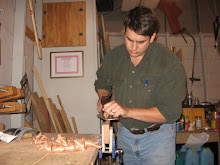I spent a lot of time in the airport figuring out how this thing is going to go together. None of the bench components are original ideas. And, I will give background information/credit where it is most appropriate. For now, I just want to get my outline up so that I will have something to go by.
The majority of the wood for both the base and the top of the bench is going to come out of the two 12/4 ash boards I posted photos of the other day. The remainder will come from some oak, cherry or black walnut. I am not sure yet how it is going to shake out.
I hope to get the drawings done for the bench this week and posted by the end of the weekend.
This is the outline for what all I can tell has to go into the bench at this time. (Sorry, the post did not appear in the outline form I had intended. It makes it a little difficult to follow).
I. CUTTING/MILLING
A. Chainsaw
1. Separate Slab 1 & Slab 2 from main slabs
B. Woodmizer
1. Take ears off of Slabs 1 & 2
2. Cut feet/leg tops/uprights length-wise
3. Cut stretchers in half length-wise
C. Chopsaw/Bandsaw
1. Cut wood to rough length
2. Cut wedges to be used in base
D. Jointer
1. Joint edges of all stock
2. Joint one face of all cut components but slab 1 & 2
E. Planer
1. Plane all stock (except slab 1 & 2) to thickness
2. Plane slab 1 & 2 to flatten (on sled if necessary)
II. BASE
A. Feet
1. Cut arches w/ either band saw or coping saw
2. Clean up with file and scraper
B. Mortise & Tenon (See: Hoadley to insure proper M&T orientation)
1. Cut tenons on risers (tenon saw, 8 total)
2. Cut mortises in feet (Drill press and chisel clean, 4 total)
3. Cut mortises in leg tops (Drill press and chisel clean, 4 total)
4. Glue up and wedge tenons
C. Stretchers
1. Cut recess in stretcher ends (Bore out and connect with coping saw)
2. Cut nut recess (Drill press and chisel)
D. Assemble base
E. Base hardware, etc.
1. Stainless machine bolts, nuts, washers, all spray painted O.D. green
2. Bullets for top out of 1" dowels
3. Cups/live rubber for under feet
III. TOP
A. Slabs
1. Biscuit jointer slots for big biscuits
2. Glue up slabs - need plenty of clamps
B. Dog Hole Strip
1. Cut dog holes (back saw and chop relief with chisel)
2. Cut tail notch
3. Cut dovetail pin
4. Biscuit joint and glue dog hole strip to top
5. Glue on dog hole strip cover
6. Glue 1" x 1" strip along backside of dog hole on bottom of bench
IV. END CAPS
A. Left End Cap
1. Cut pin
2. Groove for spline - do NOT cut full length or will show in tool till
3. Cut half-blind pins on other end
B. Right End Cap
* Needs more study in conjunction with mounting tail vise
V. TOOL TILL
A. Apron
1. Clamp apron on back of bench and mark dovetails
2. Cut dovetails and fit into end caps
3. Cut grove along bottom of apron to accept till bottom
* Till floor needs to be even with bottom of bench
B. Tool Till Floor
1. Dry fit
2. Attach to bottom of bench with screws
* screw through slots perpendicular to bench to allow for seasonal changes
C. Ramps
1. Determine and cut correct miter
2. Glue into place
VI. BOTTOM SPACERS
A. Attach with screws only (slots too)
*Note: vises need to be laid out to insure spacers do not interfere with movement
VII. FRONT VISE (Ref. Woodcraft product sheet)
A. Front Spacer Block
1. Note and bore clearance holes for dogs
2. Attach spacer to bottom of bench with glue and screws
B. Front Vise Face Block
1. Laminate vise face block
2. Bore holes for screw and guides
3. Cut rounded edge (use whatever technique worked well for feet)
C. Bench Top Prep. for Accepting Vise
1. Bore rod and screw holes (clamp face to bench for pattern)
* Holes slightly larger than guide and screw holes (approx. 1/4")
* Make sure holes are perfectly perpendicular
2. Plane flat bench and vise face
D. Attach Vise:
1. Attach vise to face block
2. Present guide rods and screw through bench face
3. From back side, slide carriage onto rods and pull flush with back of dog hole strip
4. Tighten vise screw
5. Once face block is positioned, attach carriage to bench
VIII. END VISE
* Needs more study
IX. FLATTEN TOP
A. Use smoothing and jointer plane
X. FINISH
A. Oil and wax
1. Galoot wax formula
a. 1 part beeswax
b. 1 part turpentine
c. 1 part boiled linseed oil
2. Application
a. 2x daily for 2 weeks
b. 2x weekly for 2 months
c. 2x monthly for 2 years
d. As needed for life










